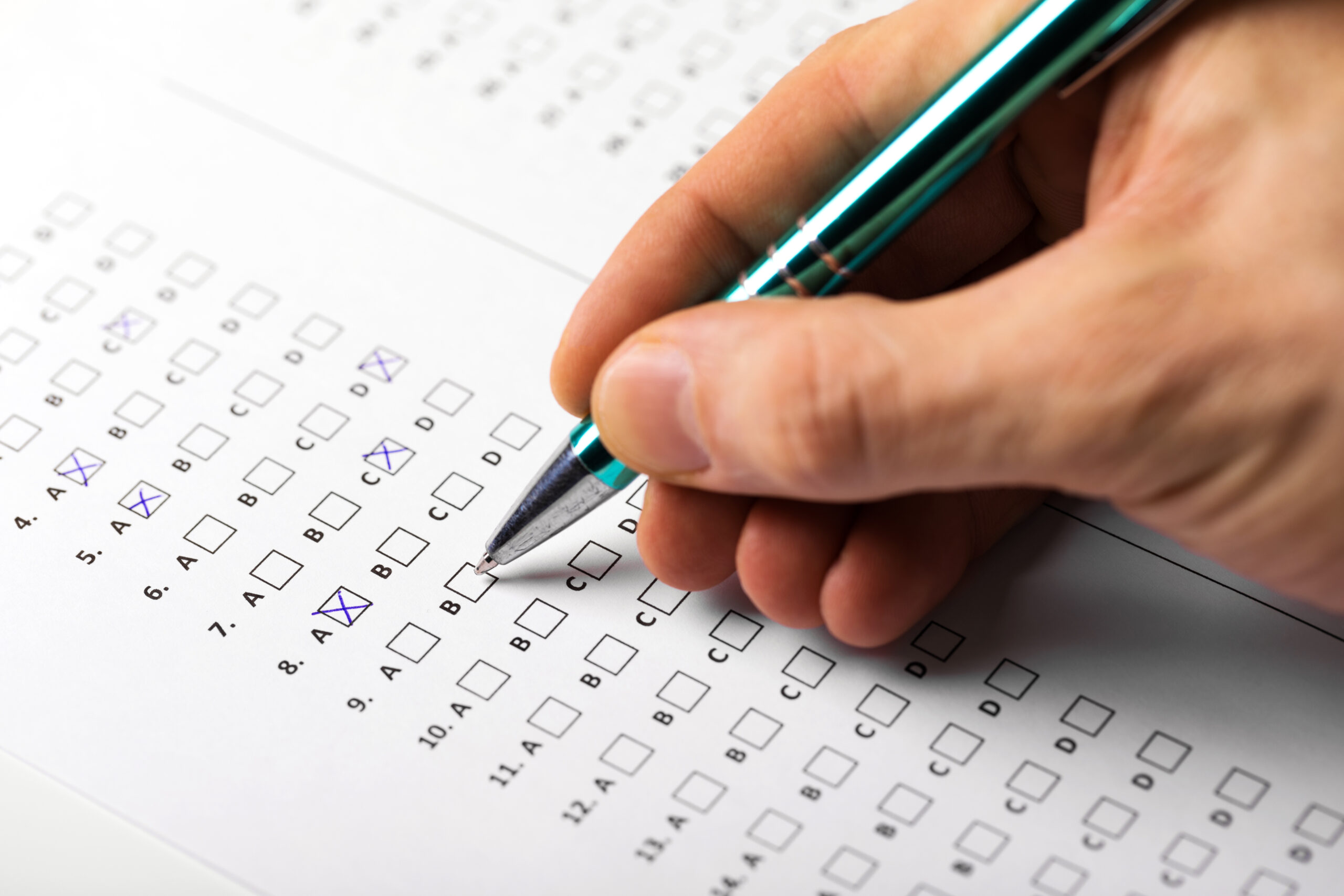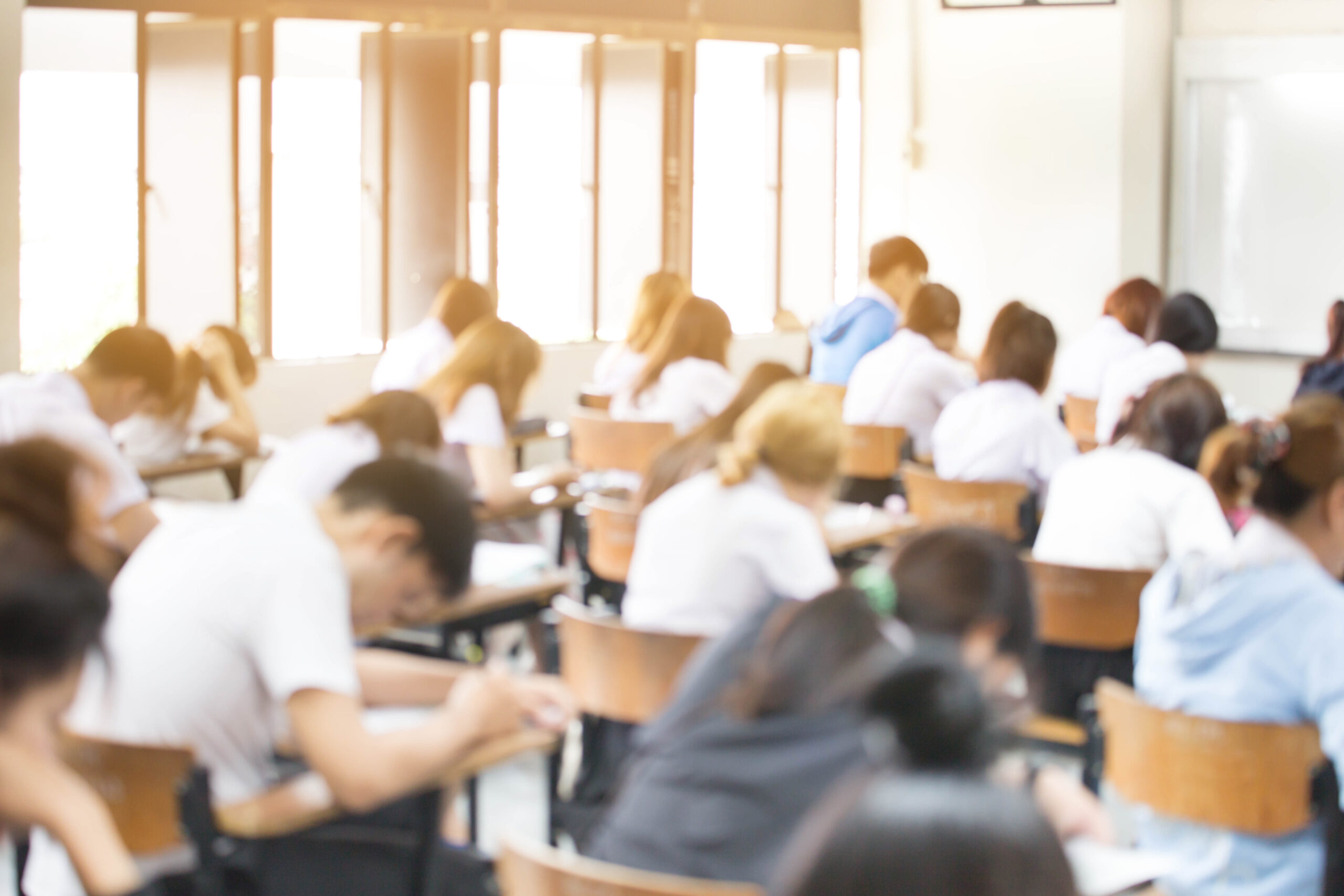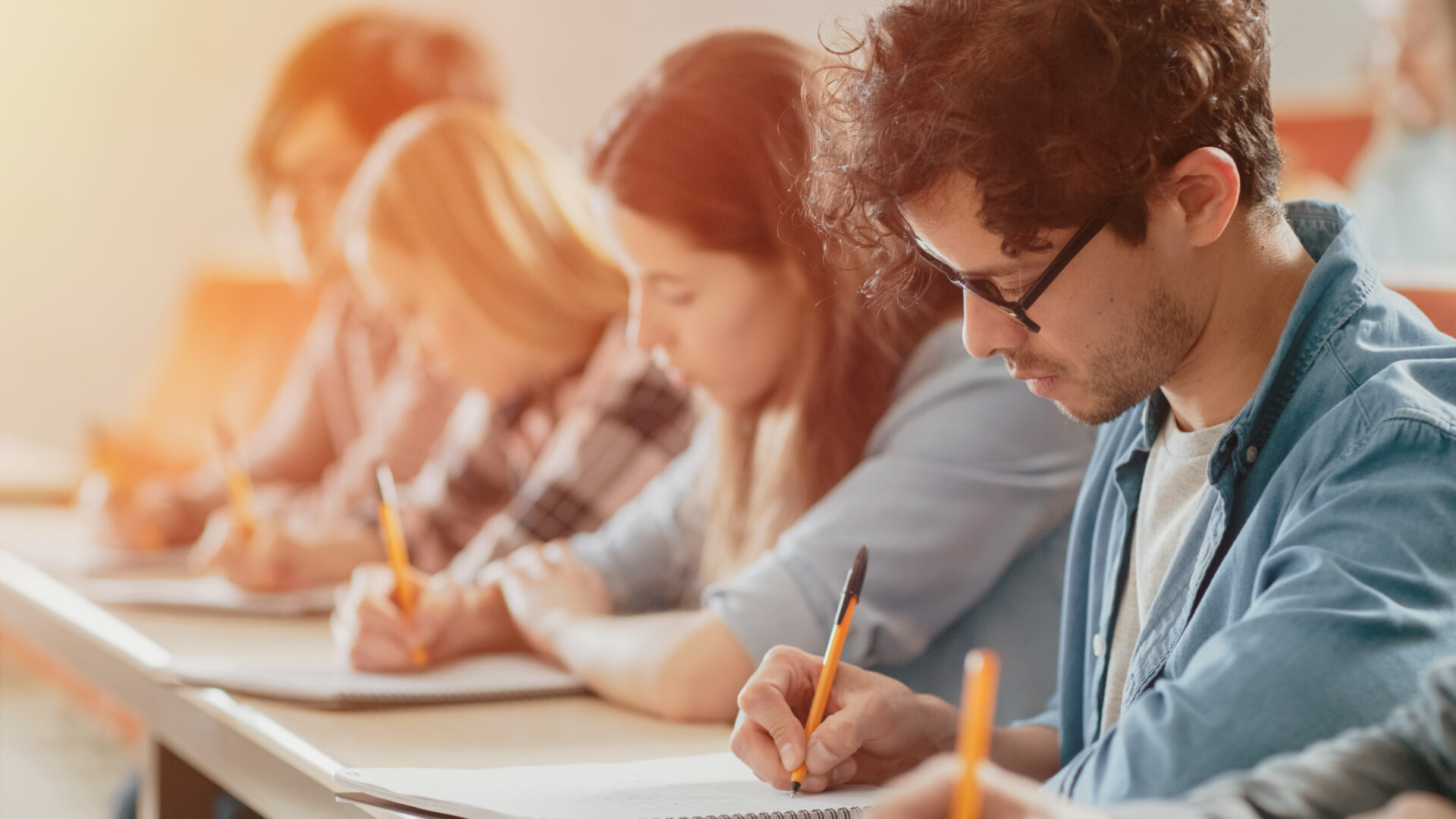Everything you need to know about the TMS!
TMS - Test for medical degree programmes
Who in Germany Study medicine and would like to apply for one of the highly competitive university places, but do not have the necessary A-level average for the best A-level quota, there is one thing that is difficult to avoid: the test for medical degree programmes - TMS for short, also known as the medical test. But what exactly is the TMS, what skills are required, when and how do you register and how do you prepare properly? To make it easier for you to get to grips with the subject, we have compiled the most important facts and some helpful tips about the infamous aptitude test here!
Are you interested in studying medicine?
We will be happy to advise you free of charge about your options for studying medicine, including advice on studying medicine in another EU country, which is fully recognised in Germany.
What is the TMS?
The TMS is an aptitude test for medical degree programmes in Germany. It is not only recognised in the application process for human medicine, but also for dentistry and veterinary medicine. Unlike other aptitude and admission tests for medicine (e.g. HAM-Nat, MedAT), the test does not test factual knowledge, but rather puts the participants' visual skills, memory, basic mathematical and scientific understanding, spatial reasoning, concentration and diligence to the test. The test can be taken independently of the Abitur (i.e. before, during or after) and may be repeated once within one year of the first participation.
When does the TMS take place?
The TMS takes place every year in spring and autumn, with two consecutive dates at numerous locations throughout Germany. The autumn TMS in particular offers an additional opportunity for applicants to improve or supplement their test results, as the applicant has had sufficient time to prepare. Registration for this takes place in January/February and July/August. The next dates with the corresponding registration deadlines can be found on the official website of the Test Coordination Centre: www.tms-info.org/fristen-und-termine.
How do I register for the TMS?
Registration for the TMS is divided into three phases, with first-time participants applying in phase 1. Phases 2 and 3 are aimed at repeaters, with those who did not receive a place for their second attempt in the previous round being prioritised in phase 2.
Registration takes place digitally via the registration portal of the test coordination centre (www.tms-info.org/anmeldeportal ). The participation fee for the test is currently €100 (as of spring 2024).
How is the TMS structured?
The TMS, designed as an aptitude test for medical degree programmes, is divided into seven subtests, each of which tests different skills. The subtests take place one after the other and are only interrupted by a one-hour break after the fourth test.
The TMS starts with the task group "Assign pattern". Carefulness and visual skills are required here, as you have to recognise tiny differences between several, mostly histological, images - and under time pressure! Completing all 24 tasks, each with 5 possible answers, in the given 30 minutes is a real challenge, but can be trained well with a lot of practice and a little patience.
We continue with the second test: "Basic medical and scientific understanding". In this test, you have 60 minutes to choose one of five correct answers to a total of 24 short medical texts. Careful reading and a basic understanding of science are very helpful here - but don't worry, although some basic biological knowledge won't hurt, factual knowledge is not necessary. So don't focus your preparation on memorising the contents of the exercise texts. All the information you need to answer the question is given in the text!
In the third sub-test "Hose figures", spatial thinking is required above all. Each of the 24 tasks shows two images of a transparent cube containing a coiled tube or a knotted rope from different perspectives. The difficulty lies in finding out from which side you have to look at the cube from the first picture in order to arrive at the second view. This test also has a very short time limit of 15 minutes, so as with the "pattern matching" test: practise, practise, practise!

Behind subtest number four, "Quantitative and formal problems" is a group of tasks that primarily puts the participants' maths skills to the test. You have 60 minutes to complete 24 tasks and should be able to deal with formulae, conversions, quantities and units. A certain amount of preparation is also very useful here in order to familiarise yourself with the types of tasks.
After the exertions of the "morning part", the well-deserved one-hour lunch break takes place after the fourth test.
This is followed by the intensive memorisation phase of the "Learn figures" and "Learn facts" continue. As the names imply, these tests are primarily about memory capacity. While you have four minutes to memorise 20 complex figures in the "Learn figures" test, you have six minutes to memorise the name, age, profession, a characteristic and a clinical picture of a total of 15 imaginary patients in the "Learn facts" test that follows immediately after. After this ten-minute memorisation phase, you have to keep all the information you have memorised in your head for a whole hour before you have to reproduce it correctly in the reproduction phase. In addition, no notes may be taken during this test.
In the hour between the imprinting and reproduction phases, basic medical and reading comprehension is tested once again. In the sixth subtest "Text comprehension" you have to prove that you can quickly grasp longer texts (approx. one A4 page) and answer the subsequent questions about the text correctly. As with the second subtest "Basic medical and scientific understanding", all the necessary information for answering the questions is provided in the text and extensive factual knowledge is not required.
After the sixth subtest has been completed and the previously learnt figures and facts have been tested in the reproduction phase of the memory tests, the seventh and final subtest "Diagrams and tables". Here, 24 diagrams and tables are to be analysed and evaluated in one hour. Although the sometimes very complex-looking diagrams can seem daunting at first, there are often similar patterns and traps in the questions, which is why it is highly recommended that you familiarise yourself with the exact types of tasks in this test as well as in the "Quantitative and formal problems".
During the test, you work in a test booklet containing the tasks and possible answers. The selected answers must then be transferred to a separate answer sheet for each task, which may only be worked on with a pencil and eraser. IMPORTANTIf the time for a sub-test has expired, you must scroll to the next test immediately. STRICTLY is prohibited and will be penalised with immediate exclusion from the test. As each subtest is printed on coloured paper in different colours, such offences will inevitably be noticed and cheating is therefore pointless. You should therefore always make sure that you tick the answers on the sheet at the same time as completing the tasks. If you don't finish a subtest in time and there are still empty boxes left on the answer sheet, it is highly recommended that you simply tick them at random to at least have a chance of getting a lucky hit or two.
How do I prepare for the TMS?
Disclaimer: Unfortunately, there is no universal secret recipe for perfect preparation. Everyone knows themselves best and should personalise their preparation! The following tips can provide a framework for all those who are unsure how to start, but any deviations are also good and correct!
You should not start preparing too early, but ideally not too late either. Depending on how much time you have and what type of learner you are, you should allow around two to three months. If you start studying too early, you risk a lack of motivation and a flattening learning curve, but starting too late can also mean stress and under-utilised potential. The daily learning time should also not be exaggerated; practising around three to four subtests per day, 5-6 days a week, is usually completely sufficient. A daily combination of visual, maths/science and memory tests makes sense.
Participants who want to prepare for the TMS can choose from a wide range of materials and preparation courses from various providers. While practice books with tips and simulations are highly recommended for preparation, the sometimes expensive courses can certainly be helpful, but are not essential.
If you want to save money, you can also buy the materials second-hand via Facebook groups or Ebay classifieds, for example. However, you should make sure that the booklets have either only been edited in pencil and rubbed out or that only copies have been used. Some publishers of test material also provide free practice material to print out.
The three original versions of the test from ITB Consulting (hogrefe Verlag) are also recommended, although their level of difficulty is significantly lower than the test level, as they are the only material published by the test manufacturer. They are particularly suitable for simulating a complete test under real-time conditions.
The TMS Coordination Centre also offers a brochure containing the exact rules and examples for all task groups as an introduction to learning: https://www.tms-info.org/wp-content/uploads/informationsbroschuere_tms-1.pdf
Sometimes it can be helpful to exchange ideas with like-minded people during preparation and thus gather tips and motivation. Contact with other TMS candidates via groups on Facebook or Telegram, for example, is also useful for discussing more difficult tasks and solutions together. However, the constant input from outside can also cause stress and lead to you comparing yourself too much with others. Depending on your type, you may therefore want to look for smaller groups or only socialise with individual other participants.

Who should take the TMS?
Participation in the TMS is voluntary, but can increase your chances of being accepted. Medical study place but increase immensely. It is relevant for all those who wish to apply via the Additional Aptitude Quota (ZEQ) or the university selection procedure (AdH). On the other hand, it has no advantage for the Abitur best quota or the preliminary quota, which is used by people from non-EU countries, second degree applicants and people with hardship applications, among others.
How does the test day work?
To ensure that the test day runs smoothly and that all regulations are complied with, it is essential to familiarise yourself with the exact procedures and requirements. The test day starts in the morning between 8 and 9 am at the test location. As admission is not possible after 9.45 a.m. and registration is required beforehand, it is important to arrive on time and to allow enough time for traffic jams, train delays and the like when travelling.
To register, you must absolutely The following items must be brought along:
the Test invitation (printed or digital)
a valid, official Photo ID (identity card, passport or driving licence)
for underage participants\innen: the completed and signed Declaration of consent a legal representative (will be sent with the invitation to underage participants\)
Strict rules apply to what can be taken into the room at the admission control afterwards. Here, too, there are a few Mandatory itemsthat everyone needs to have with them:
valid, official Photo ID (is clearly visible on the table during the entire test)
two pencils (HB, B or 2B degree of hardness) and a Eraser
TMS bracelet and TMS label strips (both will be distributed during registration)
Not absolutely necessary, but Permitted items are:
Pens for marking (not for marking on the answer sheet, only as an aid in the test booklet)
Catering
Wallet, medication, handkerchiefs
Alarm clocks, stopwatches (without computer function and without or with visual and acoustic signals that can be switched off)
Disinfectant wipes, disinfectant
Appropriate clothing for indoor areas (no scarves, jackets, etc.)
Religious clothing and headgear
Pencil sharpener
AttentionAll permitted items may only be transported in transparent containers or in their original packaging (e.g. Tupperware boxes, zip bags for the freezer, etc.)!
Expressly in the test room Prohibited articles are:
any electronic objects apart from the timer (smartwatch, mobile phone, calculator, etc.)
Cameras or camera-capable devices
Wristwatches of all kinds
Earplugs of all kinds
All other items such as jackets, rucksacks, lunches etc. can be handed in free of charge at the cloakroom.
The test itself begins after admission with a detailed explanation of the test rules and the handing out of the test booklets for the morning section. When the booklet may be opened and turned over to the next test after completion of each sub-test is announced each time and must always be followed immediately. Notes, sketches and markings may be made anywhere in the test booklet - except for the two memory tests - but only the answers on the answer sheet will be assessed.
How is the TMS assessed?
With the TMS, unlike at school, for example, you don't get a grade for how much you got right on balance, but rather depending on how well you did in relation to the other candidates. A personal percentage and a standard score (also known as a test score in the TMS) indicate how far above or below average you are. The standard score lies between 70 and 130 in a mathematically normal distribution. While the average score is 100, everyone with a higher score is above average and everyone with a lower score is below average. The percentage rank, on the other hand, indicates the percentage of the remaining participants who performed worse or equally well. A rank of 71% means, for example, that you have made it into the top 30%. This result is then used to calculate a grade equivalent at the end.
Under the conditions of the TMS, however, the result should not be over-interpreted, after all, you are competing against thousands of other, sometimes well-prepared and motivated competitors and being "only" average in a group of very good competitors is still very good!
In order to try out new tasks for future test runs, the TMS has so-called "scatter tasks" in all subtests except "Learning figures" and "Learning facts". These are individual questions that are indistinguishable from the others and must be completed as normal, but are not included in the scoring. This ensures that new questions correspond to an appropriate level of difficulty. There are 4-6 questions per subtest.

What result do I need in the TMS?
The percentage rank that is sufficient for a place to study medicine depends on several factors and varies from university to university. The respective selection criteria of the universities, the A-level average, completed voluntary services and training, professional experience and several other aspects also play a role. If you don't want to go to the trouble of researching and calculating your own chances and the result you need for each university, you can easily and conveniently use the free "ncrechner" app. All you have to do is enter your Abitur score and all other selection criteria you have met into the system, which then displays a complete overview of all German universities and your own ranking in relation to last year's borderline rankings. By entering various imaginary TMS results, you can see exactly what percentage you would have needed for which universities in recent years.
When will I receive my results?
The results can be viewed online in the application account approximately 1.5 months after the test day. They can then be used directly for the next application or, in the case of an ongoing application, submitted later for the coming semester. The results document should be downloaded and saved directly if possible, as it will only be available online for a few months.
Keeping a cool head - a guide:
For many people, preparing for the TMS is associated with an incredible amount of stress and fear of the future and failure. Especially at the beginning of the preparation, you can quickly feel overwhelmed and frustrated, and you often experience highs and lows as the test progresses. The closer the test gets, the greater the threat of Exam anxietytime pressure and the ever-increasing excitement. First things first: you are not alone! Almost all other candidates are probably going through the same emotional chaos as you, because you all have the same goal in mind. However, it is still important to deal with the difficult feelings and negative thoughts and to discuss them with family and friends if possible, but possibly even in a professional setting, for example with a therapist. If in doubt, there is no shame in deciding against or in favour of taking the test at a later date despite registering and preparing, because no test or study in the world is worth risking your mental health for! Perhaps it can help to familiarise yourself a little with possible Alternatives to studying medicine (in Germany) in order to recognise that there is not just one right way into medicine.
Frequently asked questions
FAQs on the TMS
What is the TMS?
The TMS (Test for Medical Study Programmes) is an aptitude test for medical study programmes in Germany. It tests the visual abilities, memory, basic mathematical and scientific understanding, spatial reasoning, concentration and diligence of the participants.
Who can take part in the TMS?
The TMS can be taken by all prospective students, regardless of whether they have the Abitur or not.
When does the TMS take place?
The TMS takes place every year in spring and autumn, with two consecutive dates at numerous locations in Germany.
How can I register for the TMS?
Registration takes place digitally via the registration portal of the test coordination centre (www.tms-info.org/anmeldeportal). The participation fee is currently €100.
How is the TMS structured?
The TMS consists of seven subtests that test various skills. The subtests take place one after the other and are only interrupted by a one-hour break after the fourth test.
What skills are tested in the TMS?
The TMS tests visual skills, memory, basic mathematical and scientific understanding, spatial reasoning, concentration and diligence.
How can I prepare for the TMS?
It is recommended that you start preparing around two to three months before the test. You can use practice books, take part in preparation courses or use online resources and practice materials.
Can I repeat the TMS?
Yes, the TMS may be repeated once within one year of the first participation. Both results are valid for a repeat test.
What happens if I cheat on the TMS?
Cheating is strictly forbidden and will be penalised with immediate exclusion from the test.
Can I take notes during the TMS?
During the memory tests, which contain information for later retrieval, notes are not permitted.
What happens if I do not complete a subtest of the TMS?
You should still move on to the next test. It is advisable to randomly tick all the remaining boxes on the answer sheet to have a chance of getting some correct answers.
Are there special materials to prepare for the TMS?
There are a variety of materials and preparation courses from different providers. You can use exercise books, simulations and even online courses.
Where can I find the dates and deadlines for the TMS?
You can find the dates and deadlines on the official website of the test coordination centre at www.tms-info.org/fristen-und-termine.
How long does the TMS take?
The duration of the TMS varies depending on the sub-test, with a total time of around one day including breaks.
Do I have to learn factual knowledge for the TMS?
No, the TMS does not test factual knowledge. All the information required to answer the questions is provided in the test items.
How is the TMS assessed?
The TMS is not awarded according to the number of correct answers, but according to the ratio to the other candidates.rated inside. A personal percentage rank and a standard value provide information on how far above or below average you are. The standard score lies between 70 and 130 in a normal distribution, with 100 representing the average. The percentage rank shows what percentage of the other participantshave performed worse or equally well.
What are "bedding tasks" in TMS?
Scatter tasks are individual questions in all subtests of the TMS except "Learning figures" and "Learning facts". These questions are indistinguishable from the others and must be completed as normal, but are not included in the scoring. They are used to test new tasks for future test runs and to ensure that they have an appropriate level of difficulty.
What result do I need in the TMS to get a place on a medical degree programme?
The percentage rank required for a place to study medicine varies depending on the university and can depend on various factors such as the A-level average, voluntary services completed, training, professional experience and other aspects. A helpful app for calculating your own chances is the "ncrechner".
When will I receive my TMS results?
The results can be viewed online in the application account approximately 1.5 months after the test day and can be used for the next application or submitted later in the case of an ongoing application. It is recommended that you download and save the results document immediately, as it will only be available online for a few months.
How is the grade equivalent calculated in the TMS?
A grade equivalent is calculated from the percentile rank and the standard score. This indicates how well you perform compared to the other candidates.inside has done. However, it is important to remember that the result should not be over-interpreted, as you are competing with thousands of other, sometimes well-prepared and motivated candidates.inside.
What are the advantages of the "ncrechner" app?
With the app "ncrechner" you can enter your Abitur score and all other selection criteria you have fulfilled. The system then gives you a complete overview of all German universities and your own rank in relation to last year's borderline ranks. This allows you to see exactly what percentage rank you would have needed for which universities in recent years.
Conclusion
We hope we have been able to give you a good overview with this summary, but we are always happy to receive suggestions and questions on this or other topics related to studying medicine. If you are about to start preparing for the test or are already in the middle of it, we wish you every success and perseverance!
This article was written by Maria Kieschke.
Starting signal
What are you waiting for? 🎉
Order your info pack now, find out more about the Studying medicine abroad and get started as a medical student!
Studying medicine abroad










